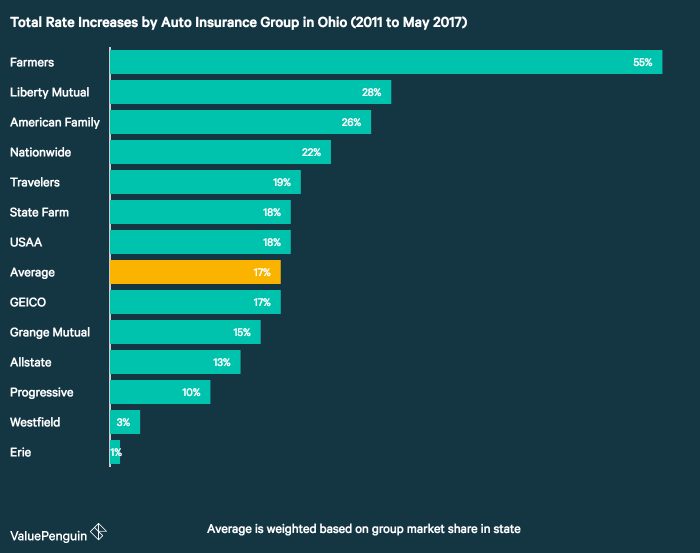Securing the right auto insurance in Ohio can feel like navigating a complex maze. Understanding the state’s requirements, the factors influencing premiums, and the options available is crucial for every driver. This guide unravels the intricacies of Ohio’s auto insurance landscape, offering clear explanations and practical advice to help you make informed decisions and find the best coverage for your needs.
From understanding minimum coverage requirements and penalties for non-compliance to exploring various coverage types and strategies for lowering premiums, we aim to equip you with the knowledge necessary to confidently navigate the world of Ohio auto insurance. We’ll also delve into crucial topics like uninsured/underinsured motorist coverage and the process of filing a claim, ensuring you’re prepared for any eventuality.
Ohio Auto Insurance Requirements

Driving in Ohio requires adhering to the state’s minimum auto insurance requirements. Understanding these requirements is crucial to avoid legal penalties and ensure financial protection in the event of an accident. This section details Ohio’s minimum coverage mandates, potential penalties for non-compliance, available coverage types, and a comparison of insurance costs across various Ohio cities.
Minimum Auto Insurance Coverage in Ohio
Ohio law mandates minimum liability coverage for bodily injury and property damage. This means drivers must carry insurance that covers damages they cause to others in an accident. The minimum required coverage is $25,000 for bodily injury to one person, $50,000 for bodily injury to multiple people in a single accident, and $25,000 for property damage. This is often referred to as 25/50/25 coverage. It’s important to understand that this coverage protects others, not yourself. If you are at fault in an accident, this insurance will cover the costs of injuries and damages to the other party. However, it won’t cover your own medical bills or vehicle repairs.
Penalties for Driving Without Insurance
Driving in Ohio without the minimum required auto insurance is a serious offense. Penalties can include significant fines, suspension of your driver’s license, and even jail time, depending on the severity of the offense and any prior violations. Furthermore, if you are involved in an accident without insurance, you will be personally liable for all damages, potentially leading to significant financial hardship. The state actively works to identify uninsured drivers, and the consequences can be severe and long-lasting.
Types of Auto Insurance Coverage
Beyond the state-mandated minimum liability coverage, several other types of auto insurance are available in Ohio to provide broader protection.
- Liability Insurance: This covers bodily injury and property damage you cause to others. As previously stated, Ohio requires a minimum level of liability coverage.
- Collision Insurance: This covers damage to your vehicle resulting from a collision, regardless of fault. This is optional but highly recommended.
- Comprehensive Insurance: This covers damage to your vehicle caused by events other than collisions, such as theft, vandalism, fire, or weather-related damage. This is also optional.
- Uninsured/Underinsured Motorist Coverage: This protects you if you’re involved in an accident with an uninsured or underinsured driver. This coverage is crucial because it covers your medical expenses and vehicle repairs even if the at-fault driver lacks sufficient insurance.
- Medical Payments Coverage (Med-Pay): This covers medical expenses for you and your passengers, regardless of fault. This can help with medical bills even before fault is determined.
Cost Comparison of Auto Insurance in Ohio Cities
The cost of auto insurance varies significantly depending on several factors, including location, driving history, age, and the type and amount of coverage. The following table provides a hypothetical comparison of minimum versus higher coverage levels in different Ohio cities. These are estimates and actual costs may vary.
| City | Minimum Coverage Cost (Annual) | Higher Coverage Cost (Annual) | Cost Difference |
|---|---|---|---|
| Columbus | $700 | $1200 | $500 |
| Cleveland | $750 | $1300 | $550 |
| Cincinnati | $650 | $1100 | $450 |
| Toledo | $600 | $1050 | $450 |
Understanding Ohio’s Uninsured/Underinsured Motorist Coverage

Ohio law requires drivers to carry minimum liability insurance, but accidents involving uninsured or underinsured drivers are unfortunately common. This is where uninsured/underinsured motorist (UM/UIM) coverage becomes crucial, offering vital protection for you and your passengers. Understanding this coverage is key to ensuring adequate financial protection in the event of an accident.
Uninsured/underinsured motorist coverage protects you and your passengers from the financial consequences of an accident caused by a driver who lacks sufficient insurance or is uninsured altogether. It compensates for medical bills, lost wages, property damage, and pain and suffering resulting from the accident. The peace of mind provided by having this coverage is invaluable, given the prevalence of uninsured drivers on Ohio roads.
Benefits of Uninsured/Underinsured Motorist Coverage
This coverage is essential because it bridges the gap when the at-fault driver’s insurance is inadequate or nonexistent. Many drivers operate vehicles without sufficient insurance, and even those with insurance may not carry enough to cover the full extent of damages in a serious accident. UM/UIM coverage ensures you’re not left to shoulder the financial burden alone.
Typical Coverage Limits
The limits of UM/UIM coverage are typically expressed as monetary amounts, such as $25,000/$50,000. The first number represents the maximum amount payable per person injured, and the second represents the maximum amount payable per accident. Policyholders can often purchase higher limits, depending on their needs and budget. It’s important to carefully consider the limits you choose, as the costs associated with serious injuries and vehicle repairs can quickly exceed lower limits. For example, a policy with $100,000/$300,000 limits provides significantly greater protection than a policy with $25,000/$50,000 limits.
Hypothetical Scenario Demonstrating Coverage Value
Imagine you’re driving in Columbus, Ohio, and a car runs a red light, hitting your vehicle. The other driver is uninsured. You sustain serious injuries requiring extensive medical treatment, resulting in $75,000 in medical bills and $20,000 in lost wages. Your vehicle is totaled, costing $25,000 to replace. Without UM/UIM coverage, you would be responsible for these substantial costs. However, with $100,000/$300,000 UM/UIM coverage, your insurance company would cover your medical bills, lost wages, and vehicle replacement costs, providing significant financial relief during a difficult time.
Conclusion

Obtaining adequate auto insurance in Ohio is not merely a legal obligation; it’s a vital step in protecting yourself, your vehicle, and your financial future. By carefully considering the factors influencing premiums, comparing quotes from different providers, and understanding the nuances of various coverage options, you can secure a policy that provides comprehensive protection while fitting your budget. Remember, proactive planning and informed decision-making are key to navigating the complexities of Ohio’s auto insurance system effectively.
FAQ Compilation
What happens if I’m in an accident and the other driver is uninsured?
Uninsured/underinsured motorist coverage protects you in such situations. It covers your medical bills and vehicle repairs even if the at-fault driver lacks sufficient insurance.
How often can I expect my auto insurance rates to change?
Rates can change annually, or even more frequently depending on your driving record, claims history, and other factors. Review your policy regularly and contact your insurer if you have questions.
Can I get discounts on my auto insurance?
Yes, many insurers offer discounts for safe driving records, bundling policies (home and auto), and other factors. Ask your insurer about available discounts.
What is the difference between collision and comprehensive coverage?
Collision covers damage to your vehicle caused by an accident, regardless of fault. Comprehensive covers damage from events other than collisions, such as theft, vandalism, or weather damage.